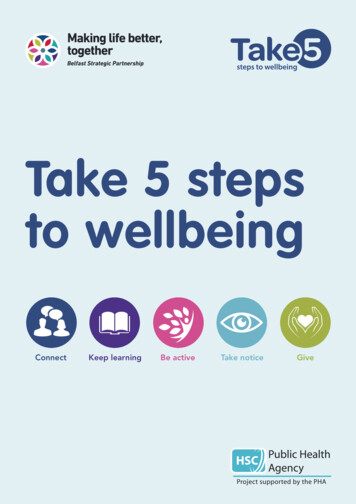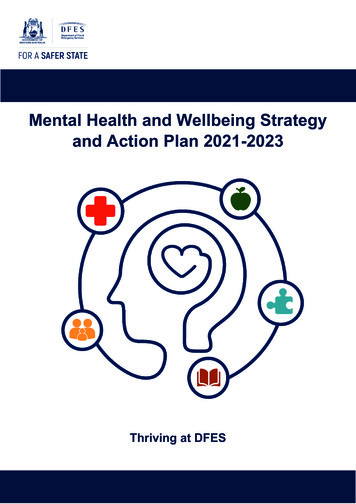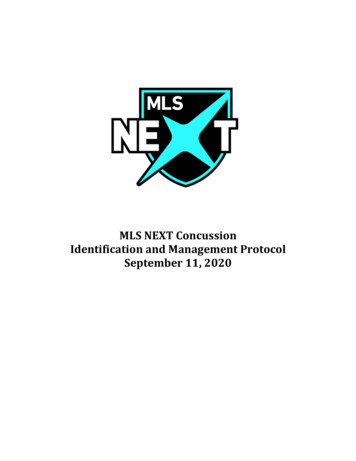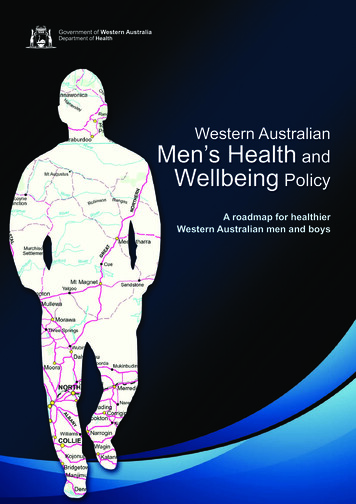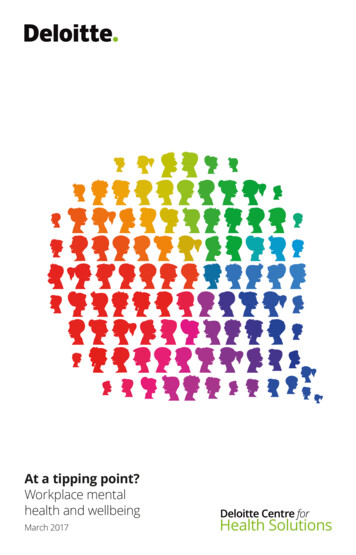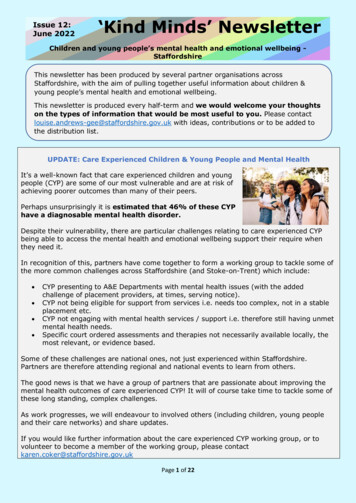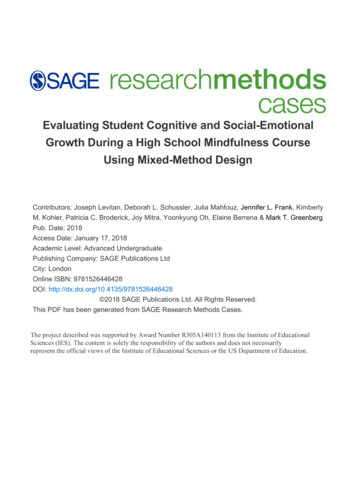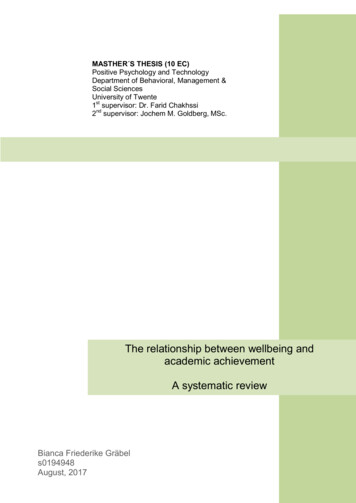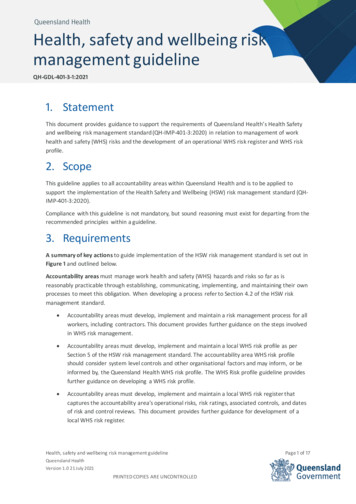
Transcription
Health, safety and wellbeing riskmanagement guidelineQH-GDL-401-3-1:20211. StatementThis document provides guidance to support the requirements of Queensland Health’s Health Safetyand wellbeing risk management standard (QH-IMP-401-3:2020) in relation to management of workhealth and safety (WHS) risks and the development of an operational WHS risk register and WHS riskprofile.2. ScopeThis guideline applies to all accountability areas within Queensland Health and is to be applied tosupport the implementation of the Health Safety and Wellbeing (HSW) risk management standard (QHIMP-401-3:2020).Compliance with this guideline is not mandatory, but sound reasoning must exist for departing from therecommended principles within a guideline.3. RequirementsA summary of key actions to guide implementation of the HSW risk management standard is set out inFigure 1 and outlined below.Accountability areas must manage work health and safety (WHS) hazards and risks so far as isreasonably practicable through establishing, communicating, implementing, and maintaining their ownprocesses to meet this obligation. When developing a process refer to Section 4.2 of the HSW riskmanagement standard. Accountability areas must develop, implement and maintain a risk management process for allworkers, including contractors. This document provides further guidance on the steps involvedin WHS risk management. Accountability areas must develop, implement and maintain a local WHS risk profile as perSection 5 of the HSW risk management standard. The accountability area WHS risk profileshould consider system level controls and other organisational factors and may inform, or beinformed by, the Queensland Health WHS risk profile. The WHS Risk profile guideline providesfurther guidance on developing a WHS risk profile. Accountability areas must develop, implement and maintain a local WHS risk register thatcaptures the accountability area’s operational risks, risk ratings, associated controls, and datesof risk and control reviews. This document provides further guidance for development of alocal WHS risk register.Health, safety and wellbeing risk management guidelineQueensland HealthVersion 1.0 21 July 2021PRINTED COPIES ARE UNCONTROLLEDPage 1 of 17
WHS risk management must be supported by consultation with workers at each step. For furtherinformation on consultative forums and processes, refer to the HSW consultation standard and HSWconsultation guideline.This guideline outlines the WHS risk management process (Section 3.1) and provides guidance on howto develop a WHS risk register (Section 3.2) of identified WHS hazards, risks, and controls. The purposeof a WHS risk profile is also outlined (Section 3.3), with further guidance on developing a WHS riskprofile available in the WHS risk profile guideline.Queensland Health resources available to support WHS risk management include: a Queensland Health WHS Risk Profile tool a generic work health and safety risk assessment tool an occupational violence risk assessment tool (OVRAT) a hazardous chemicals storage risk assessment tool a chemical tasks risk assessment worksheet and tool a Patient Handling Facility/Unity Risk Assessment Tool (FURAT) a guideline on Preparing a WHS risk profile.How to manage work health and safety risks code of practice 2021 further outlines requirementsfor WHS hazard identification, assessment, control, and review of WHS risk control processes.Health, safety and wellbeing risk management guidelineQueensland HealthVersion 1.0 21 July 2021PRINTED COPIES ARE UNCONTROLLEDPage 2 of 17
Figure 1: Overview of the WHS risk management process and requirements for accountability areasHealth, safety and wellbeing risk management guidelinePage 3 of 17Queensland HealthVersion 1.0 21 July 2021PRINTED COPIES ARE UNCONTROLLED
3.1. WHS Risk managementSections 3.1-3.3 of this guideline provide guidance for Sections 4 and 5 of the HSW risk managementstandard.3.1.1. PurposeRisk management is a process for: identifying hazards and assessing risks arising from work activities and the work environmentmaking decisions about ways to eliminate or minimise those risks and continue to monitorthem.Managing work health and safety risks is an ongoing process that is triggered when any changes affectwork activities or the work environment.The steps of risk management should be undertaken when: changing work practices, procedures or the work environmentpurchasing new or used equipment or using new substances new information about workplace risks becomes availableresponding to workplace incidents (even if they have caused no injury)responding to concerns raised by workers, health and safety representatives or others at theworkplace.3.1.21.2.3.4.A four-step risk management processIdentify hazardsAssess risksControl risksReview control measures1. Identify hazardsIdentifying hazards involves finding all of the things and situations that could potentially cause harm topeople. Some hazards may be more obvious than others because they are common in healthcare.It is important to work closely with workers who perform, or will perform, the work to help identify allpotential hazards.Information and records on incidents, near misses and the results of inspections can also help identifyhazards. If someone has been injured during a work task, then a hazard exists.2. Assess the riskA risk assessment can help determine: what the contributing factors are (e.g. nature of the hazard, work environment, systems ofwork and equipment) how severe the risk is whether any existing control measures are effectiveHealth, safety and wellbeing risk management guidelineQueensland HealthVersion 1.0 21 July 2021PRINTED COPIES ARE UNCONTROLLEDPage 4 of 17
what actions are needed to control the risk how urgently those actions need to be completed.A risk assessment is unnecessary if you already know the risk and how to control it. If, after identifying ahazard, you already know the risk and how to control it effectively, you may simply implement thecontrols.A risk assessment is required when: a new hazard is identified a work activity is being planned, introduced or changed a change to the work environment is planned (new equipment, new roster, workforcerestructure) changes at the workplace may impact the effectiveness of existing control measures.Risk ratingA risk can be rated from the combination of the consequence or severity of the resulting injury orillness and the likelihood of injury or illness arising from exposure to the hazard. Appendix A outlinesconsequence and likelihood tables that can be used to assist with the assessmentConsequence - what is the potential impact of the hazard? How severe could an injury or illness be? What is the worst possible harm the hazard could cause?Likelihood - how likely is the hazard to cause harm? Is it highly likely or unlikely to happen? How frequently are workers exposed to the hazard? (Is it constant or only occasional?)This can be mapped on a risk matrix to help rate the risk, based on the consequence and likelihoodassessment, and to prioritise managing the risk with controls.Risk matrixLikelihood Consequence NegligibleMinorModerateMajorExtremeAlmost certainMedium (7)Medium (11)High (17)Very high (23)Very high (25)LikelyMedium (6)Medium (10)High (16)High (20)Very high (24)PossibleLow (3)Medium (9)High (15)High (18)High (22)UnlikelyLow (2)Medium (8)Medium (12)Medium (14)High (21)RareLow (1)Low (4)Low (5)Medium (13)High (19)3. Control risksThe most important step in managing risks is identifying a control from the hierarchy of risk control thatmost effectively eliminates the risk, or where that is not reasonably practicable, minimises the risk.Health, safety and wellbeing risk management guidelineQueensland HealthVersion 1.0 21 July 2021PRINTED COPIES ARE UNCONTROLLEDPage 5 of 17
The hierarchy of control measuresWays of controlling risks can be ranked from the highest level of protection and reliability to the lowest.If elimination is not reasonably practicable, you must minimise the risk so far as is reasonablypracticable by doing one or more of the following: Elimination. Always aim to eliminate the hazard, which is the most effective control. Substitution. Substitute the hazard creating the risk with something safer. Isolation. Physically separate the hazard from people, by distance or using barriers. Engineering controls. Implement engineering controls, such as modifications to equipment. Administrative controls. Work methods or procedures that are designed to minimise exposureto a hazard (e.g. the use of signs to warn people of a hazard; job task rotation to reduceexposure). Personal protective equipment (PPE). Any remaining risk must be minimised with suitable PPE,such as providing workers with breathing protection, hard hats, gloves, protective eyewear.Administrative control measures and PPE rely on human behaviour and tend to be least effective inminimising risks. Administrative controls and PPE are only to be used when there is no other practicalcontrol available or used to supplement higher level control measures.The relevant accountability area delegate will need to review and approve proposed risk controls beforethey are implemented. Prioritising a timeframe for planning the risk treatment and implementing thecontrols will be dependent on the risk rating. (Refer to Appendix A for further information).4. Review control measuresControlling health and safety risks is an ongoing process. Risk controls must be reviewed regularly tovalidate that they are still effective.A review of risk controls, and if necessary, a revision is required: when the control measure does not control the risk it was implemented to control before a change at the workplace which is likely to give rise to a new or different health andsafety risk that the control measure may not effectively control if a new hazard or risk is identified if the results of consultation with workers indicates a review is necessary if a health and safety representative requests a review.If problems are found, go back through the risk management steps and make further decisions on howto treat the risk through controls.When deciding how frequently to carry out a review, consider the level of residual risk that remainsafter control/s have been put in place. The greater the risk, the more frequently controls should bevalidated through planned reviews. (Appendix A has further information).How to manage work health and safety risks code of practice 2021 further outlines requirements forhazard identification, risk assessment, risk control and review of controls.Health, safety and wellbeing risk management guidelineQueensland HealthVersion 1.0 21 July 2021PRINTED COPIES ARE UNCONTROLLEDPage 6 of 17
3.2. WHS Risk register3.2.1 PurposeWHS risk registers are detailed operational documents that provide an overview of all relevant WHSrisks in an accountability area. An operational WHS risk register and its associated four-step riskmanagement process are requirements under safety legislation.A WHS risk register captures an accountability area’s operational risks, risk owner/s, risk ratings,associated controls, implementation timeframes and dates of risk and control reviews. It doesn’t limitthe need to conduct dynamic risks assessments where circumstances, work tasks/environments orapproaches change the risk and/or affect the associated controls that are documented in risk registers.Directors and managers use WHS risk registers to maintain oversight and manage their WHS risks andrequired controls in their operational areas. Unresolved WHS risks, where deemed major or strategic,may be escalated to the accountability area’s strategic risk register and/or the accountability area’sWHS risk profile, in consultation with relevant subject matter experts, with the intention of raising theaccountability area’s executive leaders’ awareness of these risks.The WHS risk register is intended to be accessible to staff in the accountability area and is regularlyupdated as risks are assessed by relevant personnel who are knowledgeable in WHS risk management.(In some accountability areas the WHS risk register may be integrated into the strategic risk register,rather than existing as a separate register).3.2.2 Guide for developing WHS risk registersAccountability areas are required to develop, implement and maintain an operational WHS risk registerfor their operational areas in accordance with the local accountability area’s procedure/s. WHS riskregisters should be developed by subject matter experts in consultation with workers who areexperienced with the accountability area’s key processes, operations and associated WHS risks andcontrols.WHS risk registers should record the following information described in Section 5 of the HSW riskmanagement standard and at Appendix B, which includes:1.identified hazards and risks2. the risk rating3. existing WHS risk controls and initial WHS risk rating4. required response based on the initial WHS risk rating5. additional risk treatment/controls to be applied (consider opportunities for improvement in WHSrisks and controls)6. details of consultation with workers, HSRs, safety committees and shared duty holders, includingcontractors7.risk control owner/s (including differentiation between owner/s of existing risk controls andowner/s of additional risk controls, as required)Health, safety and wellbeing risk management guidelineQueensland HealthVersion 1.0 21 July 2021PRINTED COPIES ARE UNCONTROLLEDPage 7 of 17
8. completion date of additional risk treatment/controls9. residual risk rating10. timeframes and process for WHS risk control review (see Section 3.2.3 for further detail)11. outcomes of review/s.Responsibilities and processes relating to the WHS risk register, including requirements for review,should be documented in the accountability area’s risk management procedure. (Refer to the HSWplanning standard and HSW planning guideline for further information.)3.2.3 Validation and review of WHS risk controlsThe effectiveness of WHS risk controls may change over time due to changes in the environment,organisation, personnel, and other factors. For this reason, the effectiveness of WHS risk controlsshould be regularly validated and assessed with new and additional controls being implemented asnecessary.Along with identifying and implementing controls for WHS risks captured in the risk register,accountability areas should identify validation/review activities in relation to WHS risk controls. Thevalidation activities should include their required frequency using a risk-based approach (e.g. controlsfor higher rated risks may require more frequent validation).Validation of controls in an accountability area’s WHS risk register/s should occur periodically by linemanagement (if circumstances listed below are not present), and other competent designated role/s inconsultation with workers. The results of validation should be reported to management.Responsibilities and processes for WHS risk control validation should be described in the accountabilityarea’s HSW risk management procedure.The WHS risk register and WHS risk controls must be reviewed and revised in the followingcircumstances as described in Section 6 of the HSW risk management standard: when the control measure is not effective in controlling the risk before a change at the workplace that is likely to give rise to a new or different health andsafety risk that the control measure may not effectively control if a new hazard or risk is identified if the results of consultation indicate that a review is necessary if a health and safety representative requests a review. 3.3 WHS Risk profile3.3.1 PurposeAn accountability area’s WHS risk profile is a strategic register or report that details the accountabilityarea’s key WHS risks as identified from the local WHS risk register, with the primary purpose ofevaluating and rating the effectiveness of existing risk controls, along with other organisational riskfactors that may impact the level of risk.Health, safety and wellbeing risk management guidelineQueensland HealthVersion 1.0 21 July 2021PRINTED COPIES ARE UNCONTROLLEDPage 8 of 17
As an accountability area matures in its approach to safety risk management, the addition of a localWHS risk profile to the operational WHS risk register and associated risk management processes,assists Executive leaders to exercise due diligence and further demonstrate safety leadershipcommitment through regular reviews of the local risk profile.A WHS risk profile serves multiple purposes, including to: provide a range of information relating to WHS hazards, occupational streams, and regulatoryand organisational risksprovide a more holistic picture of the accountability area’s WHS risk landscape than theoperational WHS risk registerapply to WHS risk in lifecycle activities including purchasing, projects and contractormanagementfeed into other WHS and risk reporting structures, including the accountability area’s strategicrisk register, local WHS performance reporting and due diligence reportingprovide strategic information to evaluate during other WHS assurance activities.The Queensland Health WHS risk profile tool, details occupational streams and system-level controls inplace for identified hazards and should be referred to when developing the accountability area’s localWHS risk profile. The local WHS risk profile should then be customised to reflect the businessoperations and context, WHS hazards, risks and controls implemented, control effectiveness andresidual risk specific to the accountability area. Key risks identified in the local WHS risk profile, whichare not currently captured in the system-level WHS risk profile, may also be escalated to theDepartment of Health’s Safety and Wellbeing team, to consider for inclusion into the QueenslandHealth WHS risk profile tool.The WHS risk profile register/report is accessible to WHS personnel and executive in the accountabilityarea and is regularly updated as effectiveness of the implemented risk controls are monitored andreviewed in the accountability area. This information may be compiled into a strategic report forexecutive to analyse at the accountability area’s Senior Management review of HSW ManagementSystem effectiveness and/or integrated into local due diligence reporting.The WHS risk profile should be reviewed at least annually, updated, and reported as part of establishedWHS assurance reporting and, where applicable, other risk reporting channels.Updating of an accountability area’s WHS risk profile may also be triggered by: changes in legislationa WHS risk escalated through the operational WHS risk registerthe identification of a new WHS risk or opportunitythe result of an incidentthe result of enforcement action by a WHS Regulatorchanges to Queensland Health’s employment agreementschanges to the accountability area’s organisational structurechanges to supply, purchasing and procurementWHS issues raised in consultative forumsWHS issues raised in the industry/sector.Health, safety and wellbeing risk management guidelineQueensland HealthVersion 1.0 21 July 2021PRINTED COPIES ARE UNCONTROLLEDPage 9 of 17
Further information on developing a WHS risk profile is available in QH-GDL-401-3-2:2021 Preparing aWHS risk profile guideline.4. Diversity and inclusion considerationsWhen undertaking WHS risk management, consideration should be given to the specific needs andrequirements of different diversity groups.The cultural requirements of Aboriginal and Torres Strait Islander workers, accessibility requirements ofpeople with disability and the cultural and linguistic requirements of workers from non-Englishspeaking backgrounds are all important to consider in the WHS risk management approach.Diversity groups should be included in worker consultation mechanisms informing WHS riskmanagement, to enable the different needs of different diversity groups to be met.Implementation of risk controls will be most effective if consideration is given to the communicationrequirements of workers with different language, literacy and access needs. When communicating riskmanagement outcomes with workers, it is important to take into account the characteristics of theworkers, including language and literacy levels, and to use inclusive language, such as gender-neutralterms and avoidance of gendered language, to ensure LGBTIQ worker inclusion.5. Legislation Building Fire Safety Regulation 2008 Electrical Safety Act 2002 Electrical Safety Regulation 2013 How to manage work health and safety risks code of practice 2021 Work Health and Safety Act 2011 Work Health and Safety Regulation 2011 Workers' Compensation and Rehabilitation Act 2003, Workers' Compensation andRehabilitation Regulation 20146. Supporting documents Department of Health chemical tasks risk assessment worksheet and tool Department of Health hazardous chemicals storage risk assessment tool Department of Health occupational violence risk assessment tool Department of Health work health and safety risk assessment form General Retention and Disposal Schedule (Administrative Records) QH-GDL-401-3-2:2021 Preparing a WHS risk profile guidelineHealth, safety and wellbeing risk management guidelineQueensland HealthVersion 1.0 21 July 2021PRINTED COPIES ARE UNCONTROLLEDPage 10 of 17
QH-GDL-401-1:2021 Health, safety and wellbeing planning guideline QH-IMP-401-1:2020 Health, safety and wellbeing planning standard QH-IMP-401-2:2020 Health, safety and wellbeing consultation standard QH-IMP-401-3:2020 Health, safety and wellbeing risk management standard Queensland Health Health, safety and wellbeing risk profile tool Queensland Health Patient Handling Facility/Unity Risk Assessment Tool (FURAT)7. DefinitionsTermDefinitionAccountability areaDepartment of Health divisions and agencies and each HHS areaccountability areas within Queensland Health.Executive LeaderIs the most senior person of each accountability area and can includepersons reporting to that position.HazardSource with a potential to cause injury and ill health (see AS/NZS ISO45001:2018)Health and SafetyA Health and Safety Representative appointed under the Work Healthand Safety Act 2011Representative (HSR)Hospital and HealthHospital and health service established under the Hospital and HealthService (HHS)Boards Act 2011IncidentAn unplanned event that either resulted in or had the potential to resultin adverse outcomes such as harm, loss, damage, disruption or delay andincludes a significant incident.OthersOther persons as referenced in the WHS Act 2011. Others are people whoare not workers but whose health and safety may be impacted by one ormore accountability areas.Patients and visitors are examples of others.Person Conducting a Business orUndertaking (PCBU)Means a person conducting a business or undertaking. The Departmentof Health (including Health Support Queensland and eHealth) and eachof the HHSs are considered to be PCBUs.Safety legislationThe WHS Act 2011, and the Electrical Safety Act 2002 and any associatedregulations or WHS codes of practice, as amended from time to time.Health, safety and wellbeing risk management guidelineQueensland HealthVersion 1.0 21 July 2021PRINTED COPIES ARE UNCONTROLLEDPage 11 of 17
TermDefinitionSafety management systemThis system consists of the WHS standards framework, procedures andoperating practices that provide the framework within which workersdischarge their individual health and safety accountabilities and thePCBU ultimately discharges its legislative obligations.Shared duty holdersA shared duty holder (or other duty holder) in the Queensland Healthcontext, would be where an accountability area’s worker undertakeswork for another accountability area (or external entity), where theworker performs duties on the other accountability area’s (or externalentity’s) premises OR the reverse of this, where a worker undertakeswork for an accountability area on their premises but is not directlyemployed by said accountability area.So far as is reasonablypracticable (SFAIRP)‘Reasonably practicable’, in relation to a duty to ensure health and safety,means that which is, or was at a particular time, reasonably able to bedone to ensure health and safety, taking into account and weighing up allrelevant matters including:a. the likelihood of the hazard or the risk concerned occurring; andb. the degree of harm that might result from the hazard or the risk;andc.what the person concerned knows, or ought reasonably to know,about the hazard or risk, and about the ways of eliminating orminimising the risk; andd. the availability and suitability of ways to eliminate or minimisethe risk; ande. after assessing the extent of the risk and the available ways ofeliminating or minimising the risk, the cost associated withavailable ways of eliminating or minimising the risk, includingwhether the cost is grossly disproportionate to the risk.WHS riskThe possibility that harm (death, injury or illness) might occur whenexposed to a hazard.WHS standards frameworkThis framework consists of QH-POL-401:2020 Health, safety andwellbeing policy, implementation standards and guidance materials.WHS Hierarchy of Risk ControlThe hierarchy of risk control ranks risk controls for WHS risk from highestlevel of protection and reliability to lowest level. The WHS Regulation2011 requires duty holders to work through this hierarchy whenmanaging WHS risks.Section 36 of the WHS Regulation 2011 – hierarchy of control measuresstates:1.This section applies if it is not reasonably practicable for a dutyHealth, safety and wellbeing risk management guidelineQueensland HealthVersion 1.0 21 July 2021PRINTED COPIES ARE UNCONTROLLEDPage 12 of 17
TermDefinitionholder to eliminate risks to health and safety.2. A duty holder, in minimising risks to health and safety mustimplement risk control measures under this section.3. The duty holder must minimise risks, so far as is reasonablypracticable, by doing one or more of the following—a. substituting (wholly or partly) the hazard giving rise tothe risk with something that gives rise to a lesser risk;b. isolating the hazard from any person exposed to it;c.implementing engineering controls.4. If a risk then remains, the duty holder must minimise theremaining risk, so far as is reasonably practicable, byimplementing administrative controls.5. If a risk then remains, the duty holder must minimise theremaining risk, so far as is reasonably practicable, by ensuringthe provision and use of suitable personal protective equipment.Note—A combination of the controls set out in this section may be used tominimise a risk, so far as is practicable, if a single control is not sufficientfor the purpose.WHS OpportunityOpportunities to eliminate hazards and reduce WHS risks/opportunities toadapt work, work organisation and work environment to workers asdescribed in ANZS ISO45001 – Occupational health and safetymanagement systemsWorkerDefinition as per Section 7 of the WHS Act, that is: A person is a worker ifthe person carries out work in any capacity for a person conducting abusiness or undertaking,including work as—(a) an employee; or(b) a contractor or subcontractor; or(c) an employee of a contractor or subcontractor; or(d) an employee of a labour hire company who has beenassigned to work in the person’s business or undertaking; or(e) an outworker; or(f) an apprentice or trainee; or(g) a student gaining work experience; orHealth, safety and wellbeing risk management guidelineQueensland HealthVersion 1.0 21 July 2021PRINTED COPIES ARE UNCONTROLLEDPage 13 of 17
TermDefinition(h) a volunteer; or(i) a person of a prescribed classThe person conducting the business or undertaking is also a worker if theperson is an individual who carries out work in that business orundertaking.As per the Workers’ Compensation and Rehabilitation Act, 2003 s 11(1) (asamended 2013): A person who works under a contract with QueenslandHealth, and in relation to the work, is an employee for the purpose ofassessment for PAYG withholding under the Taxation Administration Act1953; who has sustained a work-related personal injury or illness. (Theabove definition is utilised by WorkCover Queensland when determiningliability/eligibility for workers’ compensation entitlements).8. Version ControlVersionDateComments1.021 July 2021New guideline QH-GDL-401-3-1:2021Health, safety and wellbeing risk management guidelineQueensland HealthVersion 1.0 21 July 2021PRINTED COPIES ARE UNCONTROLLEDPage 14 of 17
Appendix A - Risk assessment matrixConsequence assessmentType ofconsequencePeople,property o structural orequipmentdamage.Minorstructural orequipmentdamage.Moderatestructural orequipmentdamage.Major structuralor equipmentdamage.Catastrophicstructural orequipmentdamage.Noenvironmentaldamage.Limited escapeto onsiteenvironment.Some offsiteenvironmentaldamage.No injury/illnessor first aidtreatment only.No time lost.(SAC 4)Medicaltreatmentrequired forinjury. A fullshift has notbeen lost. (SAC3)Lost time orinjury or illnesswithoutpermanentimpairment.(SAC 2)Some offsiteenvironmentaldamage.Serious injuryor illness withpermanentimpairment.(SAC 2)Significantoffsiteenvironmentimpact.A loss of life.(SAC 1)Likelihood (probability) assessmentLikelihood of incident occurring (from assessment information gathered)LikelihoodAlmost certainExpected to occur in most circumstancesLikelyWill probably occur in most circumstancesPossibleMight occur occasionallyUnlikelyCould occur sometime but not expectedRareMay occur only in exceptional circumstancesHealth, safety and wellbeing risk management guidelineQueensland HealthVersion 1.0 21 July 2021PRINTED COPIES ARE UNCONTROLLEDPage 15 of 17
Risk matrixThe risk matrix shall be used following the likelihood and consequence assessment. Conseque
Health, safety and wellbeing risk management guideline Page 1 of 17 Queensland Health Version 1.0 21 July 2021 PRINTED COPIES ARE UNCONTROLLED. 1. Statement . This document provides guidance to support the requirements of Queensland Health's Health Safety and wellbeing risk management standard (QH-IMP-401-3:2020) in relation to management of work
